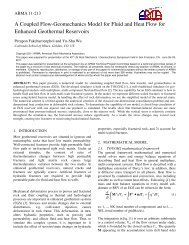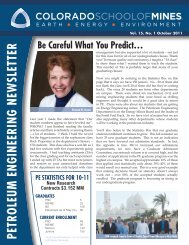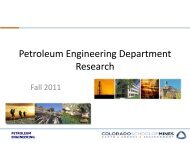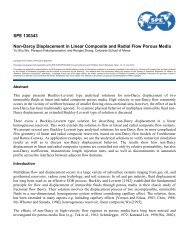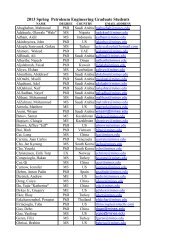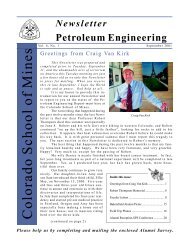SPE 146840 Pilot Testing Issues of Chemical EOR in Large ...
SPE 146840 Pilot Testing Issues of Chemical EOR in Large ...
SPE 146840 Pilot Testing Issues of Chemical EOR in Large ...
Create successful ePaper yourself
Turn your PDF publications into a flip-book with our unique Google optimized e-Paper software.
8 <strong>SPE</strong> <strong>146840</strong>Transfer functionsFor fracture and first r<strong>in</strong>g:n n1 n1n n n nw f /1 f /1km / 1.wf m P<strong>of</strong> Pom w hwf hwm 1 Pcw<strong>of</strong> Pcwom1 (26)For matrix r<strong>in</strong>g 1 and matrix r<strong>in</strong>g 2:n n1 n1n n n nw1/2 1/2km 1/ 2.wm m Pom 1 Pom 2 w hwm1 hwm 2 Pcwom 1 Pcwom2 (27)For matrix r<strong>in</strong>g 2 and matrix r<strong>in</strong>g 3:n n1 n1n n n nw2/3 2/3km 2/ 3.wm m Pom 2 Pom 3 w hwm 2 hwm 3 Pcwom 2 Pcwom3 (28)Upstream weight<strong>in</strong>g are used <strong>in</strong> the above equations. Also an <strong>in</strong>ternal matrix <strong>of</strong> coefficients has been solved to obta<strong>in</strong> matrixpressure at n+1 level <strong>in</strong> each nested matrix block. Therefore transfer function is calculated <strong>in</strong> a semi-implicit method. Solv<strong>in</strong>gnew matrix <strong>of</strong> coefficients does not affect the simulation run time. Dual-porosity without ref<strong>in</strong>ement takes 123 seconds to runwhile dual-porosity with ref<strong>in</strong>ement takes 133 seconds.As it is seen <strong>in</strong> Figure 6, compar<strong>in</strong>g to the dual-porosity without matrix ref<strong>in</strong>ement surfactant does better us<strong>in</strong>g IFTreduction and wettability alteration assumptions; two percent and 4 percent respectively. Still <strong>in</strong> this formulation viscousforce is not effective. In the next part <strong>of</strong> this paper we have built a dual-permeability model for purpose <strong>of</strong> check<strong>in</strong>g theref<strong>in</strong>ement approach and compare the results.Case 3: Dual-permeability F<strong>in</strong>e-grid FormulationIt is not exactly dual-permeability formulation but the approach is the same. The size <strong>of</strong> the model is 10x1x10 grid blocks.Each matrix has been ref<strong>in</strong>ed <strong>in</strong>to 5 sub grids <strong>in</strong> „x‟ direction to create the same ref<strong>in</strong>ement as dual-porosity model withmatrix ref<strong>in</strong>ement. All matrix blocks are connected vertically and disconnected by a fracture <strong>in</strong> „x‟ direction. There are twohorizontal fractures at the top and bottom <strong>of</strong> the bed to connect vertical fractures. After ref<strong>in</strong>ement the size <strong>of</strong> the model is55x1x15. Simulation <strong>of</strong> this model takes almost more than 2 hrs. All properties for matrix and fracture are the same as dualporositymodel. Result <strong>of</strong> simulation is shown <strong>in</strong> Figure 7.Figure 6. Dual-porosity nested matrix block,water flood recovery and <strong>in</strong>crementalsurfactant oil recoveryFigure 7. Wtareflood recovery factor and <strong>in</strong>crementalsurfactant oil recovery us<strong>in</strong>g IFT-<strong>in</strong>duced and wettabilityalteration <strong>in</strong> Dual-permeability (DK) approachWater-flood<strong>in</strong>g results <strong>in</strong> 36 percent recovery and surfactant <strong>in</strong>jection <strong>in</strong> water <strong>in</strong>vaded zone results <strong>in</strong> 6 percent <strong>in</strong>crementaloil recovery by IFT reduction and more than 8 percent by wettability alteration assumptions. Figure 8 shows comparisonbetween dual-permeability and dual-porosity re<strong>in</strong>ed matrix. In dual-permeability formulation dur<strong>in</strong>g water flood andsurfactant <strong>in</strong>jection viscous and gravity forces overcome the negative capillary pressure. In the other words these two forcesare still effective dur<strong>in</strong>g surfactant <strong>in</strong>jection. Because gravity always will be calculated from the top <strong>of</strong> the reservoir bed nomatter <strong>of</strong> what k<strong>in</strong>d <strong>of</strong> porosity or permeability exist <strong>in</strong> the system. We have shown this effect by compar<strong>in</strong>g the above modelwith another dual-permeability model that has th<strong>in</strong> impermeable layers <strong>in</strong> z direction (Figure 9). The vertical thicknesses <strong>of</strong>these layers are 0.4 ft. Both models produce almost the same, which means exist<strong>in</strong>g <strong>of</strong> some zero permeability layers wouldnot affect the oil production from dual-permeability model.



